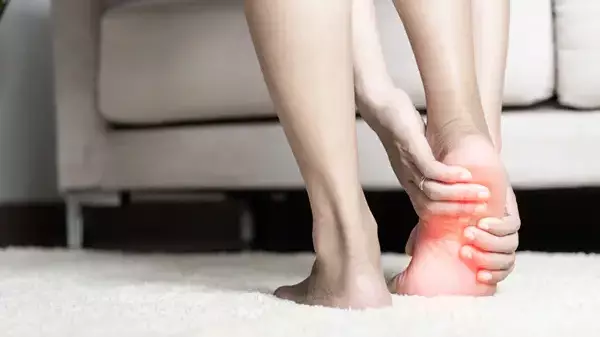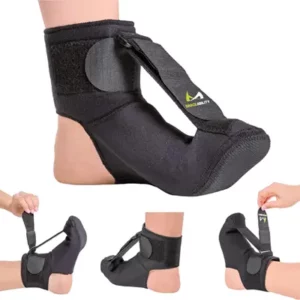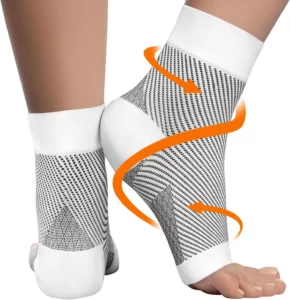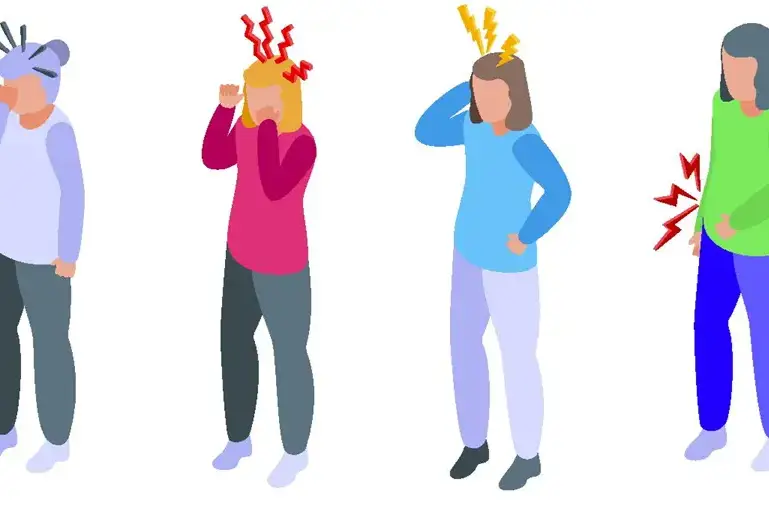Plantar fasciitis, a condition that affects millions worldwide, is a leading cause of heel pain. In fact, the terms “plantar fasciitis insoles best,” “plantar fasciitis braces,” and “plantar fasciitis night splints” are searched on Google almost 30,000 times every day.
Plantar fasciitis (also called plantar fasciosis) occurs when the plantar fascia, a thick band of tissue running across the bottom of your foot and connecting your heel bone to your toes, becomes inflamed. Understanding plantar fasciitis’s symptoms, causes, and treatments is crucial in managing this condition and alleviating pain. This blog post will detail these aspects, focusing on the benefits of using plantar fasciitis socks as part of your treatment plan.
Table of Contents
ToggleSymptoms of Plantar Fasciitis
Plantar fasciitis typically presents with the following symptoms:
- Heel Pain: The most common symptom is a sharp pain in the heel, especially noticeable with the first steps in the morning or after periods of rest.
- Stiffness: Many people experience stiffness in the heel or arch of the foot, which can improve with movement but might return after prolonged standing or walking.
- Pain After Exercise: While exercise might not cause immediate pain, discomfort often follows physical activity.
As the condition progresses, symptoms can worsen and become more persistent, making everyday activities challenging. If you experience severe or chronic pain, it’s crucial to consult a healthcare professional for a personalized treatment plan and to ensure your safety and well-being.
Causes of Plantar Fasciitis
Understanding the causes of plantar fasciitis is a key step in preventing and managing this condition. The leading causes include:
- Overuse: Repetitive stress from running, walking, or standing for long periods can strain the plantar fascia. This is particularly common among athletes and people whose jobs require long hours on their feet.
- Foot Structure and Biomechanics: Individuals with flat feet, high arches, or an abnormal walking pattern (such as overpronation or supination) are at higher risk. These structural issues can lead to uneven weight distribution and strain the plantar fascia excessively.
- Inadequate Footwear: Shoes that lack proper support or cushioning can exacerbate foot strain, leading to inflammation. High heels, flip-flops, and worn-out shoes are often culprits.
- Tight Achilles Tendon and Calf Muscles: Tightness in the Achilles tendon or calf muscles can limit ankle motion, increasing the load on the plantar fascia and leading to irritation and inflammation.
Several risk factors increase the likelihood of developing plantar fasciitis:
- Age: Plantar fasciitis is most common between the ages of 40 and 60, likely due to the natural wear and tear on the feet over time.
- Activities: Jobs or hobbies that involve prolonged standing or high-impact sports can increase the risk. This includes occupations like teaching, factory work, and activities like running or ballet.
- Obesity: Excess body weight adds stress to the plantar fascia. Every extra pound adds strain, particularly during activities such as walking or standing.
The Benefits of the Best Plantar Fasciitis Night Splints on Amazon
Plantar fasciitis socks are designed to provide targeted support and compression to the arch and heel, which can significantly alleviate pain and promote healing. Several studies and medical journals support the effective treatment of plantar fasciitis socks. For instance, a study published in the Journal of Foot and Ankle Research found that compression socks significantly reduced pain and improved function in patients with plantar fasciitis. Here’s how they work and why they’re beneficial:
- Compression and Support: These socks apply gentle pressure to the arch, providing additional support to the plantar fascia and reducing strain during movement.
- Reducing Inflammation: The compression helps to reduce swelling and inflammation, leading to decreased pain and discomfort.
- Enhancing Circulation: Improved blood flow to the affected area promotes healing and can prevent further injury.
To manage plantar fasciitis effectively, it’s crucial to balance rest, gentle stretching, and active treatment. Plantar fasciitis night splints play a vital role in helping to relieve plantar fasciitis pain. A plantar fasciitis night splint resembles a boot worn after a bad foot, ankle sprain, or fracture. You put it on your foot before you sleep, and the splint flexes the ankle and extends the toes to provide a gentle stretch while you sleep.
When the calf muscle becomes very tight, the foot is pointed down into a flexed position. This causes the ligaments and tendons in the foot to become very tight. So when you get out of bed in the morning and try to flex the foot or put weight on it, you feel pain in the bottom of the foot, specifically the heel.
That is why it’s more common to have heel pain in the morning or after being non-weight-bearing. Typically, after a few steps, the fascia begins to stretch, and the pain decreases. As you spend more time on your feet during the day, it starts to feel even better (to a point).
Night splints are usually very helpful, and research shows that many people experience significant relief from using them. However, when using plantar fasciitis night splints can be somewhat bulky and uncomfortable. An effective way to get the best response is to begin by wearing the night splint for short periods and “work” your way up to wearing it for several hours throughout the night.
What Are the Best Plantar Fasciitis Night Splints on Amazon?
BraceAbility Plantar Fasciitis Night Splint
How To Use the Best Plantar Fasciitis Night Splints on Amazon
To manage plantar fasciitis effectively, it’s crucial to balance rest, gentle stretching, and active treatment. Plantar fasciitis night splints play a vital role in relieving pain.
The best night splint plantar fasciitis resembles a “walking boot” worn after a foot or ankle sprain or fracture. You put it on your foot before you sleep, and the splint flexes the ankle and extends the toes to provide a gentle stretch while you sleep.
When the calf muscle becomes very tight, the foot is pointed down into a flexed position. This may cause the ligaments (plantar fascia) and tendons in the foot to tighten. Then, when getting out of bed in the morning, flexing the foot or putting weight on it can cause pain in the bottom of the foot and, specifically, the heel.
Typically, after a few steps, the fascia begins to stretch, and the pain decreases. As you spend more time on your feet during the day, it starts to feel even better (to a point).
Night splints are usually very helpful, and research shows that many people experience significant relief from using them. However, plantar fasciitis night splints can be somewhat bulky and uncomfortable. An effective way to get the best results is to wear the night splint for short periods and “work” your way up to wearing it for several hours throughout the night.
 The Benefits of Plantar Fasciitis Socks
The Benefits of Plantar Fasciitis Socks
Compression socks can help alleviate the pain and discomfort caused by plantar fasciitis in several ways, from soothing inflammation and supporting connective tissue to improving circulation.
Arch Support
Arch support is one of the most essential features of compression socks for plantar fasciitis. Elastic support in the arch of your foot eases strain in the plantar fascia ligaments by absorbing and redistributing the impact of your steps. Arch support also prevents the plantar fascia from stretching too much when you walk, run, or jump.
Reduced Inflammation and Pain
Plantar fasciitis pain results from ligament inflammation stretching from the base of your toes to your heel. Compression socks support these ligaments to prevent overexertion, fluid buildup in your feet and calves, and tissue swelling.
Faster Healing and Recovery
If you’re on your feet for long periods or work out frequently, compression socks can help alleviate plantar fasciitis pain. Wearing compression socks in the evenings or after a workout provides continuous support to the connective tissues in your feet and improves circulation in your feet and legs. This process helps reduce the tension and swelling that cause pain and discomfort.
What Are the Best Plantar Fasciitis Socks on Amazon?
Kemford Ankle Compression Sleeve
How to use Plantar Fasciitis Socks
Begin by wearing plantar fasciitis socks for short periods throughout the day. Some people find immediate relief from heel pain while wearing plantar fasciitis socks, while others can experience a worsening of symptoms.
Plantar fasciitis socks can be worn with or without shoes, so feel free to wear them around the house. This is often a great time to experiment with how your feet will respond to these extra supportive socks.
You can find these specific socks on Amazon. If you prefer a closed-toe plantar fasciitis sock that can be worn by itself, the Actinput plantar fasciitis support sock comes in multiple colors and is very effective! One of the primary benefits of the plantar fasciitis sock is that it can provide relief throughout the day while wearing dress shoes, work boots, and even running shoes.
Best Plantar Fasciitis Brace for Walking
Designed with targeted compression zones, this support sock effectively relieves heel and arch pain often associated with plantar fasciitis. Unlike bulky night splints, the Actinput sock is lightweight and discreet, making it comfortable for daily use while walking or standing for long periods. The breathable, moisture-wicking fabric ensures all-day comfort, while the snug fit promotes better blood circulation and supports the foot’s natural shape.
Many users find this brace particularly helpful in reducing morning foot pain, as it keeps the plantar fascia slightly stretched throughout daily activities. This makes the Actinput support sock an excellent option for those looking to maintain an active lifestyle without sacrificing comfort. If you’re searching for a reliable plantar fasciitis brace that provides both support and mobility, the Actinput Plantar Fasciitis Support Sock is an excellent investment for everyday use.
Treatments to Combine With Plantar Fasciitis Night Splints for Plantar Fasciitis
The primary goals of treating plantar fasciitis are to reduce inflammation and pain, promote healing, and improve foot function. A combination of home remedies, lifestyle changes, and professional treatments can be effective.
Home Remedies and Lifestyle Changes for Plantar Fasciitis
- Rest: Avoid activities that stress the heel, giving the plantar fascia time to heal.
- Ice Application: Applying ice to the affected area for 15-20 minutes several times daily can help reduce inflammation and pain.
- Stretching Exercises: Regular calf muscles and plantar fascia stretching can improve flexibility and reduce pain.
- Proper Footwear: Wearing shoes with good arch support and cushioning can alleviate pressure on the plantar fascia.
Exercises for Plantar Fasciitis*
Plantar Fascia Stretch with Ball
Plantar Fascia Stretch with Frozen Water Bottle
Soleus (calf muscle) Stretch
Tibialis Anterior (shin muscle) Stretch
*Thank you to physitrack.com for allowing the use of their videos!
Combine Shockwave Therapy With Plantar Fasciitis Night Splints for Plantar Fasciitis
Shockwave therapy is another non-invasive treatment for plantar fasciitis that has shown promising results. This therapy uses high-energy shockwaves to stimulate the healing process.
- Stimulating Healing: Shockwave therapy promotes natural healing by increasing blood flow and stimulating cell regeneration. The shockwaves induce microtrauma to the tissue, triggering a healing response.
- Breaking Down Scar Tissue: The shockwaves help break down scar tissue and calcifications that may have formed in the plantar fascia. This process helps remodel the tissue and restore its normal structure and function.
- Increasing Blood Flow: Enhanced circulation promotes healing and reduces pain. The increased blood flow helps deliver essential nutrients and remove metabolic waste products from the affected area.
Clinical evidence supports the use of shockwave therapy for plantar fasciitis. A review in the Journal of Orthopaedic Surgery and Research concluded that shockwave therapy is also an effective and safe treatment for chronic plantar fasciitis. Additionally, a randomized controlled trial published in the Journal of Bone and Joint Surgery demonstrated that patients treated with shockwave therapy significantly improved pain and functional outcomes compared to placebo treatments.
Off-the-Shelf Orthotics for Plantar Fasciitis
Off-the-shelf orthotics are prefabricated shoe inserts designed to provide additional support and cushioning. They can be a cost-effective and convenient option for managing plantar fasciitis.
- Arch Support: Plantar Fasciitis orthotics provide additional support to the arch of the foot, reducing strain on the plantar fascia. They help maintain proper foot alignment and distribute pressure evenly across the foot.
- Pressure Distribution: Orthotics can prevent excessive stress on the heel by evenly distributing pressure across the foot. This helps reduce the impact forces during walking and running, which can aggravate plantar fasciitis.
- Cushioning: Additional cushioning helps absorb shock and reduce impact during walking and running. This can alleviate pain and discomfort, especially for individuals with high-impact activities or prolonged standing periods.
Comparing Off-the-Shelf and Custom Orthotics
While off-the-shelf orthotics offer significant benefits, custom orthotics are another option. Custom orthotics are specifically molded to fit an individual’s foot shape and provide tailored support.
- Customization: Custom orthotics are designed based on a detailed assessment of an individual’s foot structure, gait, and specific needs. This personalized approach can more effectively address unique biomechanical issues than off-the-shelf options.
- Precision Fit: Custom orthotics provide a precise fit, ensuring optimal support and comfort. They can be particularly beneficial for individuals with severe foot deformities or complex conditions that require specialized support.
- Cost: Off-the-shelf orthotics are generally more affordable than custom orthotics. Custom orthotics involve a higher initial cost due to the personalized assessment and manufacturing process. However, they may provide longer-lasting benefits and durability.
Studies have shown that off-the-shelf and custom orthotics can effectively manage plantar fasciitis. More importantly, research published in the Journal of the American Podiatric Medical Association found that prefabricated orthotics significantly reduced pain and improved function in patients with plantar fasciitis. You can order high-quality plantar fasciitis orthotics at www.powerstep.com. Use the code “67c616d9” at checkout to get 10% off your order and free shipping.
Combine Plantar Fasciitis Night Splints With Weight Loss
Carrying even a few extra pounds can cause several health problems. Heel pain is undeniably one of them. A 2007 study found that people with a BMI (Body Mass Index) of 25 were almost twice as likely to experience chronic heel pain. In fact, another study published in the journal BMC Musculoskeletal Disorders found that people with a BMI of at least 30 were almost three times as likely to suffer from Plantar Fasciitis. For people who are experiencing Plantar Fasciitis and are also overweight, it can be challenging to be active enough to lose weight.
How to Lose Weight When You Have Plantar Fasciitis
Of course, losing weight is difficult for almost everyone. Adding the pain of Plantar Fasciitis can make losing weight seem impossible. However, losing weight while fighting Plantar Fasciitis is possible!
- Find comfortable ways to become active. Being active while dealing with Plantar Fasciitis is a challenge. The first step to addressing this problem is to choose the proper footwear. The simplest way is to replace the inserts already in your shoes with affordable and supportive inserts.
- Gradually increase activity. Consistency is also essential when losing weight. While long-term lifestyle changes aren’t flashy, they are the best way to lose weight. Begin by performing aerobic exercise for a few minutes daily, and then further increase the intensity of your exercise sessions. If you are new to exercising, begin slowly. Your first goal should be to create an exercise habit, not necessarily immediate weight loss.
- Begin with low-impact exercises. These can keep you active and help with weight loss while reducing stress on your feet. Try swimming, water aerobics, yoga, spin cycling, and rowing machines. These are excellent calorie burners, but let your feet take it easy.
- Exercise your feet and heels. While cardio and physical activity that get you moving are vital to weight loss, don’t forget arch support when exercising. Keeping the muscles and tendons in your feet limber and toned will ensure they’re in great shape to take you where you need to go.
- Manage diet alongside exercise. Activity is critical in weight loss, and it works even better when combined with dietary changes. As a rule of thumb, use the “double down” rule: Double the amount of water you drink, the amount of fresh fruits and vegetables you consume, and the amount of lean protein you eat. Limit refined foods like white flour and sugar, and be extra careful about the calories you drink (especially soda and juice).
Regarding Plantar Fasciitis and weight loss, the most crucial factor is your attitude. Don’t get discouraged by heel pain; instead, take steps to manage it and alleviate symptoms so you can get active without pain. Not only will losing weight keep heel pain at bay in the future, but it will also make staying healthy and active much easier.
Plantar Fasciitis Treatment in Denver
Plantar fasciitis can be painful and debilitating. However, if we understand its symptoms and causes, developing treatments to help manage and alleviate heel pain is easier. In addition to plantar fasciitis socks, low-level laser therapy, shockwave therapy, and off-the-shelf orthotics are all effective treatment options that can provide significant relief. If you’re struggling with heel pain, consider these treatments and contact Integrative Health and Rehabilitation to find out the best approach for your specific needs.
All things considered, early intervention and proper care are vital to overcoming plantar fasciitis and getting back on your feet pain-free. Unfortunately, for some patients, persistent plantar fasciitis can result in knee, hip, sacroiliac, or back pain. If you are also experiencing any of these conditions, don’t waste time Googling “best night splint plantar fasciitis” and schedule an appointment to learn why Integrative Health and Rehabilitation has the affordable chiropractor Denver seeks for fast, effective, and lasting pain relief with a simple Chiropractic adjustment.

Ready for an expert opinion? Get in touch today!
With a legacy of more than 25 years, our team specializes in helping individuals triumph over back pain, neck discomfort, and persistent headaches, all without relying on addictive medications or risky surgical procedures.








